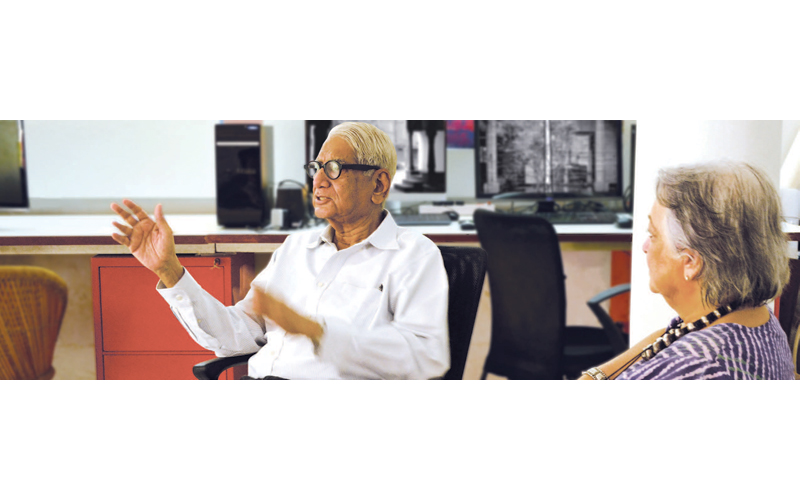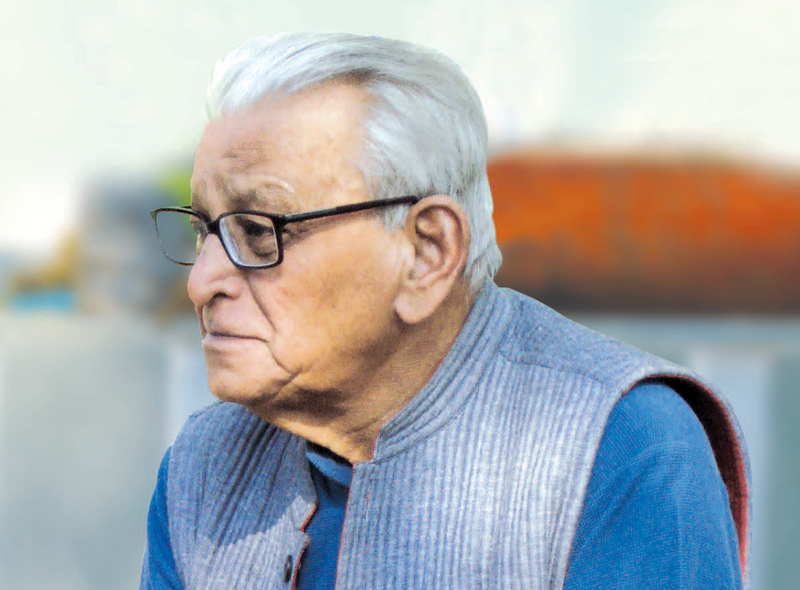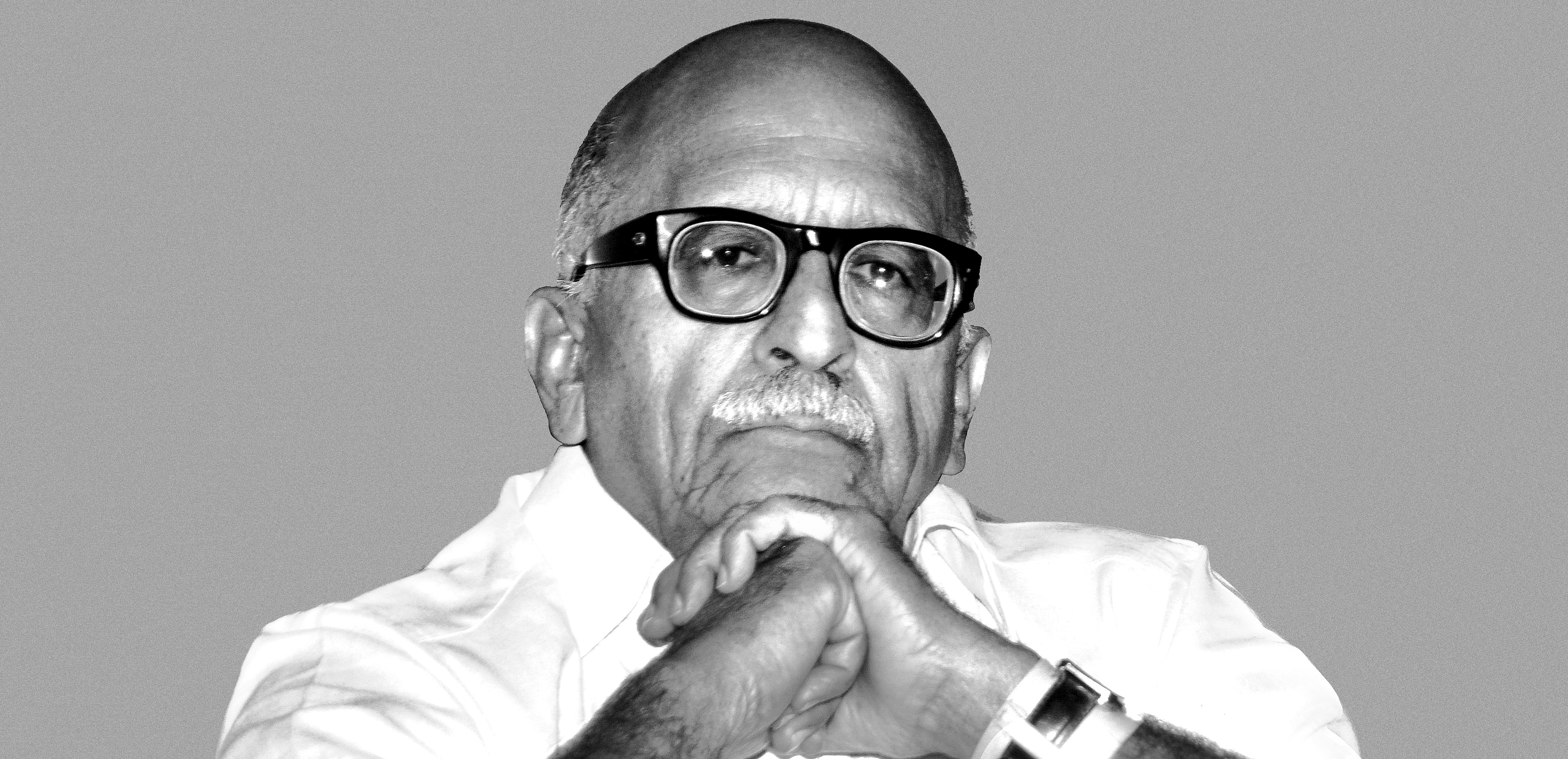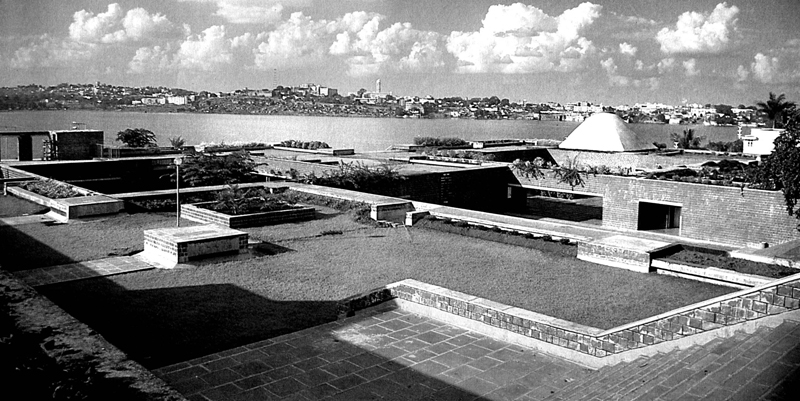Profile & Tributes
Remembering Charles Correa, Prabhakar B. Bhagwat, Nek Chand and M.N. Buch... | Ranjit Sabikhi | Ruturaj Parikh | Geeta Wahi Dua
LA 45 |
|
| Remembering Charles Correa, Prabhakar B. Bhagwat, Nek Chand and M.N. Buch... |
|
 |
Photo credit: Charles Correa; and, Incremental Housing, Belapur |
|
Charles Correa (1930-2015)
Ranjit Sabikhi |
I first met Charles Correa in the early sixties soon after I had started practice in Delhi. Charles had been in practice for a few years in Bombay and was already well known in the architecture fraternity as a talented designer, and an eloquent speaker defining the future of Indian architecture. He was a brilliant conversationalist and it was always a stimulating experience to interact with him. He had a wide range of interests, which included explorations into the background of traditional architecture, and the theories that defined sacred construction. His fascination with the Vastu Purusha Mandala and the definition of the sacred void signifying both shunya (the absolute void) and bindu (the source of all energy) found expression in a modern form, in many of his major projects bringing about a fusion of the traditional and the modern world.
Some of his earliest works were basic, simple and modest, with a play of light and space that was deeply moving. A visit to the Gandhi Memorial complex at the Sabarmati Ashram in Ahmedabad in the mid 60's, still remains a memorable experience for me. The Bharat Bhavan Arts Centre in Bhopal built more than a decade later embodied the same simplicity of form and space, along with a sensitive integration into the landscape of its setting making it almost invisible as architecture. This same quality of the anonymity of architecture pervades the National Crafts Museum in Delhi.
Ruturaj Parikh |
I first met Mr Correa when I was working with the magazine Indian Architect & Builder. The Champalimaud Centre for the Unknown had just been completed and the first photos of the inaugural ceremony were released. I had sent a general request for publishing the building in the magazine and Dhawal from then Mr Correa's office called to ask if we could come down to Sonmarg, his residence, for a meeting. Finally, I was meeting the man whom I considered a myth; too tall to exist in flesh and blood. Throughout architecture school, Charles Correa was an enduring idea.
His texts were clear and always held a moment of joyful realization of truth. There were multiple copies in the architecture school library of his two books- the blue monograph and 'Housing and Urbanisation', and these issued out by students almost all the time. You could see from the softness of the book spines that people had indulged in them, and were photocopied extensively, read and re-read, scribbled on, underlined, scanned and almost all corners were folded. Presentations were made on his buildings. His designs were referred to in almost all student reviews. Students made study models of his summer and winter architectural sections. There was a certain reverence with which we used to look at his work - authentic, modern, expressive architecture; an architecture of India.
Geeta Wahi Dua |
Since the passing away of Charles Correa earlier this summer, many eminent professionals, writers and colleagues have shared their views for what he meant to them. At this point of time, it is quite difficult to articulate thoughts and views about him which have not been written before or shared in print or social media. At the same time, the desire to share impressions about him in the Journal is quite strong.
With the multifaceted personality that Correa was, it is worthwhile to explore what makes him such a giant figure in the design profession in India other than his iconic building compositions and architectural marvels.
Prabhakar B Bhagwat (1930-2015)

Prof. Bhagwat during a lecture on Plant Selection and Propagation Methods, Baroda, 2008.
Balkrishna Doshi |
For close to six decades we were family friends and professional colleagues, it is difficult to believe that Prabhakar Bhagwat would leave us so suddenly.
We both constantly exchanged views on landscape and architecture and our dialogues and debates became more intense when he agreed to start the department of landscape architecture at the Central for Environmental Planning and Technology (CEPT) in Ahmedabad. It took a while for me to pursue Prabhakar since he could only head the department if he had full freedom to lead.
Mohammad Shaheer|
Professor Bhagwat belonged to the generation of Achyut Kanvinde, Balakrishna V. Doshi and Charles Correa. It's entirely appropriate to see his contribution to landscape architecture as somewhat parallel to that attributed to these pioneers in architecture. Apart
perhaps from one or two notable exceptions he was virtually the sole active representative in his field till the mid- 1970's. The architects had the great good fortune to catch the train of modern Indian architecture 'on time' -as Correa might have said-just as it was steaming out after independence; landscape architecture unfortunately came along very late, even though its beginnings can be traced to a symposium in Delhi as early as 1958.
It was the Seminar on Landscape Architecture held at the School of Planning and Architecture, at which Professor Bhagwat - 28 years old at the time - and his father B. V. Bhagwat - then retired Superintendent of Empress Gardens, Pune - were delegates along with other illustrious participants such as the renowned ecologist Dr G.S. Puri and including a contribution from Walter George, who had come to India as an assistant to Edwin Lutyens, but stayed back to create many fine buildings. You could say that this was how Professor Bhagwat's association with the Delhi School began.
Aparna Rao|
Any narrative of landscape architecture in India would be incomplete without a mention about Prof. Prabhakar B Bhagwat. A renowned landscape architect, town planner, environmental consultant, horticulturist and above all a remarkable 'teacher', Professor Prabhakar B Bhagwat dedicated an entire lifetime to establish the relevance of landscape as a profession in India. The sobriquet 'Bade Sir' given by his students at CEPT is perhaps no mere coincidence.
Prof. Bhagwat's engagement with gardens began at an early age of sixteen as an apprentice trainee at the Empress Botanical Gardens in Pune. He worked with Carl Theodor Sorenson, Professor of Landscape Architecture at the Royal Academy of Fine Arts in Copenhagen. His equation with his teacher at Newcastle-upon-Tyne, the eminent Prof. Brian Hackett, had a lifelong impact on him. Their conversations as student-teacher were often reminisced by him while talking about landscape architecture.
Nek Chand (1924-2015)

Photo credit: Isaya Higa. Photo source: http://nekchand.com/
He conceived and built it, day by day, almost single-handedly, joined by his family on weekends, for more than a decade, away from camera lights, media or public view, just
following his heart. Rock Garden, as it is popularly called, is an exceptionally creative endeavour - the result of determination, perseverance, and faith of one
man's dream - Nek Chand.
Working as a Roads Inspector of the Public Works Department in Punjab in early 50's, Nek Chand, driven by sheer passion, quietly started building the garden, in a rocky ravine hidden from view. It was around the same time when the new city of Chandigarh was being planned.
M.N. Buch (1934-2015)

Photo credit: ISOLA Conference, Bhopal 2012
Savita Raje|
It is difficult to believe that Mr M.N. Buch, a man of action, is no longer with us. He has left us the legacy of his inspiring works that ensure the well-being of so many living species. Mr Buch was not just an ardent city planner, but also a forester and an environmentalist. He was brave, prompt and impatient to get the things right. He always seemed to be in a race against time. During his lifetime, he received the highest decorations, awards and felicitations, including the prestigious Padma Bhushan by Government of India.
Mr Buch laid a great stress on the inclusion of nature, in all its glory, into the cities. The Bhopal Development Plan 1991, with Mr Buch at the helm, noted that a "Landscape Plan for the city must be prepared", which at the time and even today is quite a unique observation. On many occasions, when ideas were floated about a typical utilitarian approach towards the development of the Upper Lake - a historic 11th century water body 30 square miles in area, Mr. Buch kept reiterating that, "the Upper lake should be allowed to flourish in its natural look."
|
|


|
|

|
|
|
|
| CURRENT ISSUE: LA-61 |
|
|
|
|
environment, ecology and biodiversity |
RESCUING THE URBAN POLLINATORS
MADHURA KHADE
WETLANDS AT WORK
UNDERSTANDING WETLANDS
With inputs from Dr. C. R. Babu
CONSTRUCTED WETLAND AT RAJOKRI, NEW DELHI
[Delhi Jal Board]
Ankit Srivastava
CONSTRUCTED WETLAND AT NEELA HAUZ, NEW DELHI
Landscape and Environment Planning Department,
Delhi Development Authority
CONSTRUCTED WETLAND AT HAUZ KHAS LAKE, NEW DELHI
Tarun Nanda, Evolve Engineering
RESTORATION AND REJUVENATION OF RIVER YAMUNA FLOODPLAINS, NEW DELHI
Landscape and Environment Planning Department,
Delhi Development Authority
REIMAGINING THE CITY
YAMUNA RIVER PROJECT:NEW DELHI URBAN ECOLOGY
[Authors Inaki Alday and Pankaj Vir Gupta]
Review by Geeta Wahi Dua
REJUVENATION AND RESTORATION OF URBAN PONDS, GURUGRAM
Future Institute
SPURRING ECONOMIC REVIVAL THROUGH ECOLOGICAL RESTORATION,
NANHU, CHINA
Uma Sekar
heritage, urban design, landscape architecture |
FROM MY HOUSE TO YOUR HOUSE
In conversation with Miki Desai
CITY MAPS: MAPPING NATURE AND ENVIRONMENT
Review by Rabindra J. Vasavada
A SENSE OF SPACE
Anuraag Chowfla
IN CONVERSATION WITH RANJIT SABIKHI
DEMOCRACY, PARTICIPATION AND CONSULTATION
In conversation with Bimal Patel
city and culture |
OUR CITIES CAN FIGHT COVID-19 PROACTIVELY
Mriganka Saxena and Puneet Khanna
LOCALIZING FUTURES
Geeta Wahi Dua
BOURGEOIS ENVIRONMENTALISM AND THE VULNERABILITY OF THE POOR
UNCIVIL CITY: ECOLOGY, EQUITY AND THE COMMONS IN DELHI [Author: Amita Baviskar]
Review by Nikhil Dhar
STREETSCAPES IN PUNE
CREATING A HEALTHY AND WALKABLE NEIGHBORHOOD: AUNDH NEIGHBORHOOD UPGRADATION | PUNE
Prasanna Desai Architects
ABOUT RETAIL, TREES AND YOUNG VIBES:
JANGLI MAHARAJ ROAD | PUNE
Oasis Designs Inc.
EMERGENCE OF THE EPHEMERAL
Bijoy Ramachandran
seeing the unseen |
ART FOR ALL
St+Art India Foundation
|
|